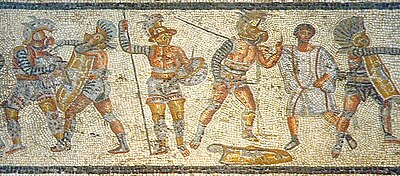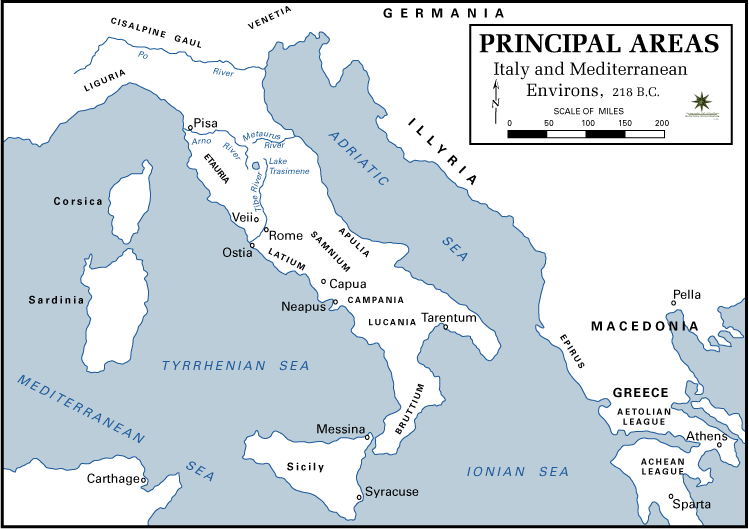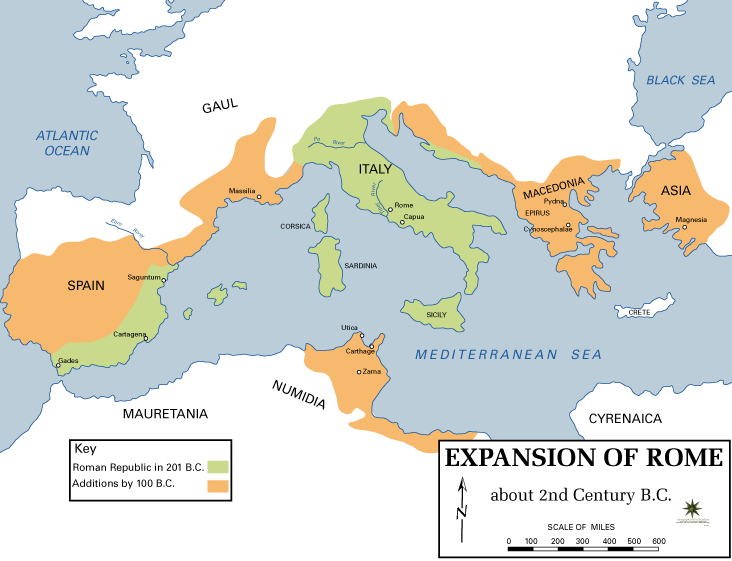The 1st-century BC Greek historian Dionysius of Halicarnassus indicates that the Roman institution of slavery began with the legendary founder Romulus giving Roman fathers the right to sell their own children into slavery, and kept growing with the expansion of the Roman state. Slave ownership was most widespread throughout the Roman citizenry from the Second Punic War (218–201 BC) to the 4th century AD.
The Twelve Tables, Rome's oldest legal code, have brief references to slavery, indicating that the institution was of long standing. In the tripartite division of law by the jurist Ulpian (2nd century AD), slavery was an aspect of the ius gentium, the customary international law held in common among all peoples. The "law of nations" was neither natural law, which existed in nature and governed animals as well as humans, nor civil law, which was the body of laws specific to a people. All human beings are born free (liberi) under natural law, but slavery was held to be a practice common to all nations, who might then have specific civil laws pertaining to slaves. In ancient warfare, the victor had the right under the ius gentium to enslave a defeated population; however, if a settlement had been reached through diplomatic negotiations or formal surrender, the people were by custom to be spared violence and enslavement. The ius gentium was not a legal code, and any force it had depended on "reasoned compliance with standards of international conduct."

In 216 BCE, Marcus Ameilius Lepidus, late consul and augur, was honoured by his sons with three days of gladiatora munera in the Forum Romanum, using twenty-two pairs of gladiators. Ten years later, Scipio Africanus gave a commemorative munus in Iberia for his father and uncle, casualties in the Punic Wars. High status non-Romans, and possibly Romans too, volunteered as his gladiators. The context of the Punic Wars and Rome's near-disastrous defeat at the Battle of Cannae (216 BCE) link these early games to munificence, the celebration of military victory and the religious expiation of military disaster; these munera appear to serve a morale-raising agenda in an era of military threat and expansion. The next recorded munus, held for the funeral of Publius Liciniusin in 183 BCE, was more extravagant. It involved three days of funeral games, 120 gladiators, and public distribution of meat.

The enthusiastic adoption of gladiatoria munera by Rome's Iberian allies shows how easily, and how early, the culture of the gladiator munus permeated places far from Rome itself. By 174 BC, "small" Roman munera (private or public), provided by an editor of relatively low importance, may have been so commonplace and unremarkable they were not considered worth recording:
Many gladiatorial games were given in that year, some unimportant, one noteworthy beyond the rest — that of Titus Flamininus which he gave to commemorate the death of his father, which lasted four days, and was accompanied by a public distribution of meats, a banquet, and scenic performances. The climax of the show which was big for the time was that in three days seventy four gladiators fought.
In 105 BCE, the ruling consuls offered Rome its first taste of state-sponsored "barbarian combat" demonstrated by gladiators from Capua, as part of a training program for the military. It proved immensely popular. The ludi (state games), sponsored by the ruling elite and dedicated to deity a divine or heroic ancestor, began to include the gladiator contests formerly restricted to private munera.
| Belligerents | |
|---|---|
| Army of escaped slaves | Roman Republic |
| Commanders and leaders | |
| Spartacus† Crixus† Oenomaus† Castus† Gannicus† | Gaius Claudius Glaber† Publius Varinius† Gnaeus Cornelius Lentulus Clodianus Lucius Gellius Publicola Gaius Cassius Longinus Gnaeus Manlius Marcus Licinius Crassus Gnaeus Pompeius Magnus Marcus Terentius Varro Lucullus Lucius Quinctius Gnaeus Tremellius Scrofa |
| Strength | |
| 120,000 escaped slaves and gladiators, including non-combatants; total number of combatants unknown. | 3,000+ militia 8 Roman legions (40,000–50,000 men) 12,000+ other troops |
| Casualties and losses | |
| 30,000 (including Crixus) killed by Lucius Gellius Publicola, 6000 crucified by Crassus, 5000 crucified by Pompeii, almost all others killed or crucified | Unspecified but heavy (50, 1,000, or 4,000 lost through decimation) |
 According to the differing sources and their interpretation, Spartacus either was an auxiliary from the Roman legions later condemned to slavery, or a captive taken by the legions. Spartacus was trained at the gladiatorial school near Capua, belonging to Lentulus Batiatus. In 73 BC, Spartacus was among a group of gladiators plotting an escape.
According to the differing sources and their interpretation, Spartacus either was an auxiliary from the Roman legions later condemned to slavery, or a captive taken by the legions. Spartacus was trained at the gladiatorial school near Capua, belonging to Lentulus Batiatus. In 73 BC, Spartacus was among a group of gladiators plotting an escape.
The plot was betrayed but about 70 men seized kitchen implements, fought their way free from the school, and seized several wagons of gladiatorial weapons and armor. The escaped slaves defeated a small force sent after them, plundered the region surrounding Capua, recruited many other slaves into their ranks, and eventually retired to a more defensible position on Mount Vesuvius.
Once free, the escaped gladiators chose Spartacus and two Gallic slaves—Crixus and Oenomaus—as their leaders. Although Roman authors assumed that the slaves were a homogeneous group with Spartacus as their leader, they may have projected their own hierarchical view of military leadership onto the spontaneous organization of the slaves, reducing other slave leaders to subordinate positions in their accounts.
Now you are about to see the view that the generals wish to have, and see the flexible and heavily armed romans legions against the slaves with hungry of freedom led by professional gladiators, the fight will decide the future of Rome and the freedom and peace of the people on both sides, and the world will not be the same before!

Sem comentários:
Enviar um comentário